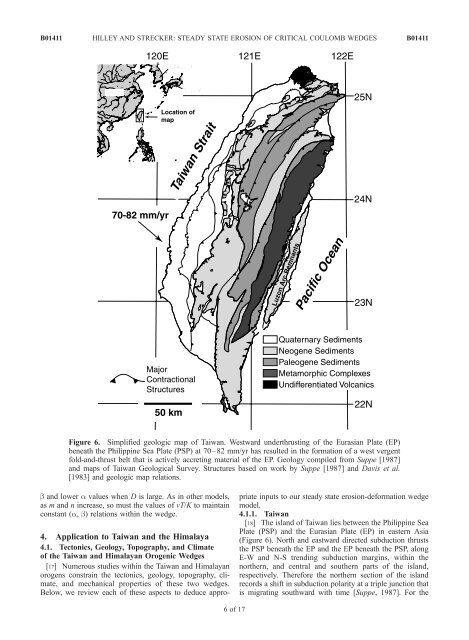Steady state erosion of critical Coulomb wedges with applications to ...
Steady state erosion of critical Coulomb wedges with applications to ...
Steady state erosion of critical Coulomb wedges with applications to ...
Create successful ePaper yourself
Turn your PDF publications into a flip-book with our unique Google optimized e-Paper software.
B01411 HILLEY AND STRECKER: STEADY STATE EROSION OF CRITICAL COULOMB WEDGES<br />
Figure 6. Simplified geologic map <strong>of</strong> Taiwan. Westward underthrusting <strong>of</strong> the Eurasian Plate (EP)<br />
beneath the Philippine Sea Plate (PSP) at 70–82 mm/yr has resulted in the formation <strong>of</strong> a west vergent<br />
fold-and-thrust belt that is actively accreting material <strong>of</strong> the EP. Geology compiled from Suppe [1987]<br />
and maps <strong>of</strong> Taiwan Geological Survey. Structures based on work by Suppe [1987] and Davis et al.<br />
[1983] and geologic map relations.<br />
b and lower a values when D is large. As in other models,<br />
as m and n increase, so must the values <strong>of</strong> vT/K <strong>to</strong> maintain<br />
constant (a, b) relations <strong>with</strong>in the wedge.<br />
4. Application <strong>to</strong> Taiwan and the Himalaya<br />
4.1. Tec<strong>to</strong>nics, Geology, Topography, and Climate<br />
<strong>of</strong> the Taiwan and Himalayan Orogenic Wedges<br />
[17] Numerous studies <strong>with</strong>in the Taiwan and Himalayan<br />
orogens constrain the tec<strong>to</strong>nics, geology, <strong>to</strong>pography, climate,<br />
and mechanical properties <strong>of</strong> these two <strong>wedges</strong>.<br />
Below, we review each <strong>of</strong> these aspects <strong>to</strong> deduce appro-<br />
6<strong>of</strong>17<br />
B01411<br />
priate inputs <strong>to</strong> our steady <strong>state</strong> <strong>erosion</strong>-deformation wedge<br />
model.<br />
4.1.1. Taiwan<br />
[18] The island <strong>of</strong> Taiwan lies between the Philippine Sea<br />
Plate (PSP) and the Eurasian Plate (EP) in eastern Asia<br />
(Figure 6). North and eastward directed subduction thrusts<br />
the PSP beneath the EP and the EP beneath the PSP, along<br />
E-W and N-S trending subduction margins, <strong>with</strong>in the<br />
northern, and central and southern parts <strong>of</strong> the island,<br />
respectively. Therefore the northern section <strong>of</strong> the island<br />
records a shift in subduction polarity at a triple junction that<br />
is migrating southward <strong>with</strong> time [Suppe, 1987]. For the
















